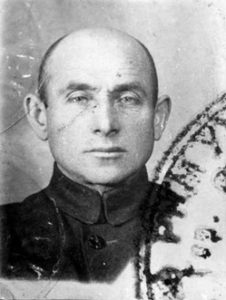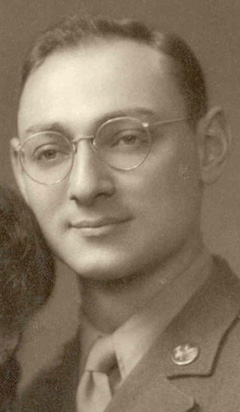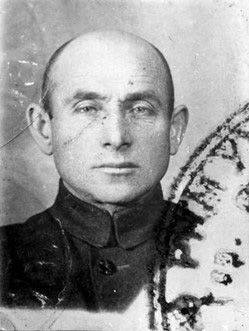by Louise Goldstein
I began my genealogy journey with a short list of research priorities, “mysteries” to solve. One of them was to discover who from my family had survived World War II, and what had happened to those who had not survived. A critical key to my success was something I’d never heard of, but would come to greatly appreciate ― the Brest Ghetto Passport Archive.
Who Was There to Find?
My paternal grandfather Sol (Sjoel) Goldstein never talked about his family or World War II, so I assumed that we had not lost family in the Holocaust. Towards the end of his life in 1975, when I asked, he told me about his family. He gave me the names of his parents ― Berko Fayvel and Yachet (Yocheved), his siblings, and some of their spouses. At the time of the war, the family lived in Terespol and Brest, directly opposite each other on different sides of the Bug River, then in eastern Poland.
Grandpa did not name his nieces and nephews, with one exception. Asked about survivors of World War II, he said only “My nephew Sol (Shloime) Goldstein survived by going to Palestine in 1935,” and that there was a great-niece with an uncertain name.
In that same conversation my grandfather also said that the family name in Poland had been “Goldshtern” (Polish: Goldsztern), but over the years I had forgotten this detail. I always save my hand-written notes, and many years later, after being reminded by a cousin, I checked my notes, and there it was. The family name was written as “Goldstein” on his older brother Shimon’s ship manifest and was adopted by those who later immigrated to the US.
The Brest Ghetto Passport Archive
In June 1941, when the German army occupied Brest, then in Poland and now in Belarus, local Jews were compelled to register with the new authorities. This list was used to identify all the Jews who would have to report the following December when the ghetto was established. Their names, parents’ names, birth year, registration date, and signatures were recorded. These signatures, written in the hand of each individual Jew, may be the only remaining personal evidence that these people had lived. Photos were taken, which in 1999 were available only in a Belorussian archive.
In 1999, while exploring various resources on JewishGen.org, I came across a World War II-era registry, now known as the Brest Ghetto Passport Archive. Because Terespol is so close to Brest, there was a good chance that my family had been in that ghetto and would appear in this registry, so I immediately started to explore it.
It didn’t take long to find three family names on the registry: my grandfather’s brother Yudel Moishe, Yudel Moishe’s son Hersch, and his sister Tila Brandt’s son Yudel, whose identities I confirmed based on known parents’ names and/or birth years. This was the first evidence showing how our family had been caught in the Holocaust. There were other Goldshtern’s on the registry, but since I didn’t know more names of spouses and children, I couldn’t confirm that they were my family.
The Brest Ghetto Passport Archive gave me an important clue as to where the family had been living during the war and, therefore, where to focus my future research. Given that the ghetto was liquidated on October 15 1942 and all the residents killed in a mass grave at Bronaya Gora, it was safe to assume that many Goldshtern family members died in the “Holocaust by bullets”, rather than in concentration camps.
I began reciting Kaddish for Yudel Brandt and Yudel Moishe and Hersch Goldshtern every year on the yahrtzeit of the liquidation.
Building Out the Tree
As the 2000’s progressed, I used JRI-Poland extensively and found many documents that allowed me to corroborate and add to what my grandfather Sol had told me, obtaining names for his siblings’ spouses, but names for only a couple of their children. JewishGen’s ViewMate was invaluable in getting those documents translated from Russian and Polish, and I am indebted to its volunteers.
JewishGen.org’s databases did yield the 1912 birth registration for the Shloime who had gone to Palestine; I eventually confirmed his aliyah in 1935 through the Central Zionist Archives in Jerusalem.
In 2019 a professional researcher in Belarus found Sarah Voiskovskaya Goldshtern, my grandfather’s brother Yudel Moishe’s wife, in Brest, but still no children’s names.
The Mother Lode at Yad Vashem
In late 2018, because more documents are digitized and uploaded all the time on every genealogy website, I revisited Yad Vashem’s website, which, like that of JewishGen.org, includes the Brest Ghetto Passport Archive. There I found a photo of Yudel Brandt, one of the names I had found in 1999 in that archive. It took my breath away as his resemblance to my father Isadore, his first cousin, was undeniable.

Encouraged, I searched Yad Vashem again for “Goldshtern” and “Brandt.” Jackpot! I was rewarded with several screens with many names from the Brest Ghetto Passport Archive, including my grandfather’s brother Uszer, his wife Dvoirah, some of their children, Uszer’s son from his first wife and his family, Yudel Moishe’s wife Sarah and their children and more members of the Tila Goldshtern Brandt family. They all had roots in Terespol and Brest. Truly a rich mother lode! And even better, photos taken at the time of their registration were included with some of the records, like the one of Yudel Brandt shown here.
My search efforts revealed that many of these family names also appeared on lists of persecuted people and residents of Brest, 1940-41; a couple of those names, however, were not in the Brest Ghetto Passport Archive. Either these people were not registered and therefore would not be on the list, were registered but their records were lost or omitted from the archive name list, or they didn’t turn up in my search for some unknown reason. They may have had a different fate and further research is needed.

I have also found the Brest Ghetto Passport Archive and the lists of persecuted people on the United States Holocaust Memorial Museum website.
The following year, in September 2019, I found a series of Yad Vashem Pages of Testimony that had been filled out in 1999 by a woman named Pnina Goldshtern Shaufer. They were all from the family of Asher and Dvoirah Goldshtern of Terespol, Poland; the children’s names were new to me, but I knew from grandpa Sol that Uszer’s wife was named Dvoirah. Importantly, this Asher’s parents were listed as Fayvel and Yachet, my grandfather’s parents’ names. Pnina listed Asher as her grandfather from Terespol, Poland, and wrote that Asher owned a tallit (prayer shawl) factory there. My great-grandfather Berl Fayvel Goldshtern owned a tallit factory in Terespol.
I found more Pages of Testimony filled out by someone named Shraga Goldshtein, né Goldshtern, for his father Yaakov (Yankel) and sister Rivke, also from Terespol, and listing Asher and Dvoirah Goldshtern as Yankel’s parents. This information matched my own too neatly to be random, especially since “Uszer” is a Yiddish pronunciation of “Asher.”
I cross-checked the Brest Ghetto Passport Archive with the names from the Pages of Testimony and, except for Yaakov Goldshtern and his family, there they were! Some I had seen in the archive before, but now I was able to confirm the relationship. Between the archive and the lists of residents and persecuted people in Brest, the picture of the family tree was coming into focus.
I had a strong suspicion that Asher Goldshtern was my grandfather Sol Goldstein’s older brother, Uszer. But suspicion isn’t confirmation, I needed to establish contact with the two submitters of these Pages of Testimony.
Making Contact
I read Hebrew well enough to decipher most of the information on the Pages of Testimony and was able to locate Pnina Goldshtern Shaufer. On October 24, 2019, we spoke by telephone. It didn’t take long to establish that Pnina’s grandfather Asher was indeed “Uszer” and that he was my grandfather Sol’s older brother, making Pnina and me second cousins. As we confirmed these connections, Pnina spoke faster and faster, repeating in excitement and wonder, “I have relatives!” She had thought they had no family anywhere in the world. I also learned that Shraga Goldshtein, whose surname was changed due to a long-ago clerical error, was Pnina’s brother.
We already had planned a visit to Israel in February 2020, where we met Pnina and Shraga and their families, our long-lost relatives. Pnina gave me a few more names of her father’s sisters that I hadn’t seen yet. We learned why they and Yaakov Goldshtern, their father, did not show up in the Brest Ghetto Passport Archive: they had evacuated eastward before the Germans occupied Brest. Pnina, Shraga, and their mother Chana survived the war in Kazakhstan; Yaakov was taken away by Soviet military authorities and never seen again.
The Brest Ghetto Passport Archive is a rich source for genealogists with family in the ghetto’s catchment area, parts of which are now in eastern Poland and Belarus. It helped me focus my research efforts where they were most likely to be fruitful, and filled out the family tree with previously unidentified spouses and children. Most importantly to me, it told me who were the people who actually made up my family, what their lives were like during the war, and how those lives were stolen from them.
Finding these surviving Goldshtern cousins is the most gratifying success of my genealogical research; we have met a few times in Israel and regularly stay in touch. Now I recite Kaddish for the twenty-seven Goldshtern’s I have identified who did not survive ― their lives are no longer forgotten.
Editor’s Research Notes and Hints
Louise Goldstein began her research by speaking to her grandfather about his family, learning the names of her grandfather’s parents and siblings.
Exploring JewishGen’s databases, Louise came across a registry of Jews living in Brest, where her family came from. Intrigued, and using her genealogy instincts, she explored the registry for family names.
Discovering names of people on the list who could be family, Louise cross-checked these names with known information of names and birth dates.
Searching other sources, e.g., JRI-Poland, Yad Vashem Pages of Testimony, and USHMM, and Central Zionist Archives in Jerusalem, Louise discovered additional family members.
Louise hired a professional researcher in Belarus to do further research when she had “hit a wall”, and used JewishGen’s Viewmate to ask for help in translating documents.
Using the Pages of Testimony submitter’s name, Louise found two living relatives in Israel.
